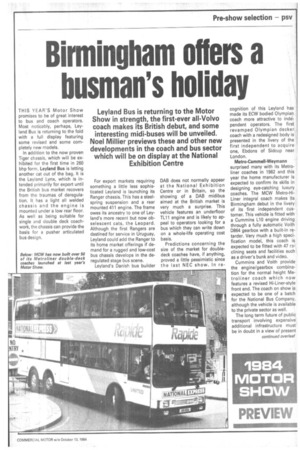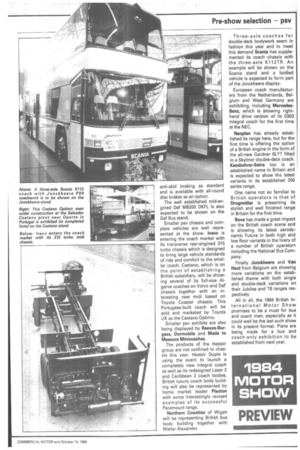Birmingham offers a busman's holiday
Page 61

Page 62

Page 63

If you've noticed an error in this article please click here to report it so we can fix it.
Leyland Bus is returning to the Motor Show in strength, the first-ever all-Volvo coach makes its British debut, and some interesting midi-buses will be unveiled. Noel Millier previews these and other new developments in the coach and bus sector which will be on display at the National Exhibition Centre
THIS YEAR'S Motor Show promises to be of great interest to bus and coach operators. Most noticably, perhaps, Leyland Bus is returning to the fold with a full display featuring some revised and some completely new models.
In addition to the now proven Tiger chassis, which will be exhibited for the first time in 260 bhp form, Leyland Bus is letting another cat out of the bag. It is the Leyland Lynx, which is intended primarily for export until the British bus market recovers from the traumas of deregulation. It has a light all welded chassis and the engine is mounted under a low rear floor. As well as being suitable for single and double deck coachwork, the chassis can provide the basis for a pusher articulated bus design. For export markets requiring something a little less sophisticated Leyland is launching its Ranger chassis. This has a steelspring suspension and a rear mounted 411 engine. The frame owes its ancestry to one of Leyland's more recent but now obselescent cats, the Leopard. Although the first Rangers are destined for service in Uruguay, Leyland could add the Ranger to its home market offerings if demand for a rugged and low-cost bus chassis develops in the deregulated stage bus scene.
Leyland's Danish bus builder DAB does not normally appear at the National Exhibition Centre or in Britain, so the showing of a DAB midibus aimed at the British market is very much a surprise. This vehicle features an underfloor TL11 engine and is likely to appeal to operators looking for a bus which they can write down on a whole-life operating cost basis.
Predictions concerning the size of the market for doubledeck coaches have, if anything, proved a little pessimistic since the last NEC show. In re cognition of this Leyland has made its ECW bodied Olympian coach more attractive to independent operators. The first revamped Olympian decker coach with a redesigned body is presented in the livery of the first independent to acquire one, Ebdons of Sidcup near London.
Metro-Ca mmell-Weymann surprised many with its Metroliner coaches in 1982 and this year the home manufacturer is expected to confirm its skills in designing eye-catching luxury coaches. The MCW Metro-HiLiner integral coach makes its Birmingham debut in the livery of its first independent customer. This vehicle is fitted with a Cummins L10 engine driving through a fully automatic Voith D864 gearbox with a built-in retarder. Very much a high specification model, this coach is expected to be fitted with 47 radining seats and facilities such as a driver's bunk and video.
Cummins and Voith provide the engine/gearbox combination for the normal height Metroliner coach which now features a revised Hi-Liner-style front end. The coach on show is expected to be one of a batch for the National Bus Company, although the vehicle is available to the private sector as well.
The long term future of public transport involving expensive additional infrastructure must be in doubt in a view of present government policy. Be that as it may, it cannot be denied that schemes such as the West Midlands Passenger Transport Executive guided bus project have obvious advantages. These give buses the ability to operate in a narrow reserved track while retaining the flexibility necessary for normal opera tion.
The MCW guided Metrobus built for WMPTE should attract interest from British and over seas visitors to the show. The bus is basically a standard Me trobus Mark 2 decker fitted with a Gardner 6LXB engine. This drives through a Voith D851 gearbox adapted with guide wheels to operate on a special concrete track on the central reservation of a dual carriageway on a busy Birmingham Commuter route.
The Metrobus Mark 2 is suit able for supply in completely knocked down kit form for ex port customers. Another example of an underframe destined for bodying in this way also appears on this stand. The chassis is one of a batch built for the Kowloon Motor Bus Company in Hong Kong.
The final MCW exhibit is another example of the Metroliner double-deck coach. This 12-metre three-axle model was undoubtedly one of the main stars of the last NEC show and is already a familiar sight on our motorways. Several operators are using it, including National Express, Armstrong Galley and the Scottish Bus Group.
Bedford has long been a popular make for independent bus and coach operators and reaction to its first production 12metre coach should be interesting. The Bedford Venturer makes its debut and should prove well worth seeking out on the Bedford stand.
The chassis is Bedford's first to offer full air suspension and should prove a cost effective alternative in a market sector dominatedby heavier vehicles.
Bedford's new Isuza-based light van can also be used as a minibus and is worthy of attention from busmen.
Hestair Dennis expects to have a number of interesting new variations to its diverse bus chassis range on show. The Do minator chassis introduced in 1978 is expected to appear in a number of unfamiliar guises. The first to be fitted with the new Gardner 5LXCT engine is being shown — one of a batch being built for Leicester City Transport. Alongside it will probably be an East Lanes bodied version fitted with the more familiar naturally aspirated Gardner 6LXB unit.
Midi-bus chassis in the past have often compromised between bus, coach and truck requirements. Hestair Dennis is launching a new product aiming to fill a gap in the market by providing a heavy-duty lowfloor midi. The Dennis Domino has already been ordered by Greater Manchester and South Yorkshire PTEs.
The Dennis Domino is designed for 7ft 6in bodywork with a full width front entrance and a low saloon floor. The chassis design includes many features of the larger established Dennis bus range, including a Kirkstall hub reduction rear axle and full air suspension and air braking system. The chassis is powered by a transverse Perkins T6.354.4 engine driving though a Maxwell four-speed automatic transmission.
Electric traction is due to make a come-back on the Hestair Dennis stand. The third Dominator chassis expected to be shown is to be the basis of an Alexander-bodied trolleybus for South Yorkshire PTE. This chassis is in many respects a standard SYPTE Dominator with electric drive componentry fitted in place of the normal power units.
For coach operators, the Guildford-based manufacturer is expected to display a Lancet mid-engined chassis designed for 8-9 metre coachwork. This air sprung chassis has a ZF S 6.65 gearbox and a Telma retarder and is expected to be fitted with Van Hool Alizee coachwork for Bicknells of Godalming, Surrey.
The C1OM is the first ever ailVolvo integral coach andis different from any other European coach. With its long wheelbase and stainless steel sub structure this fully air-conditioned coach will make its first appearance. The 12-metre vehicle has its mid engine mounted in front of the rear axle and will be powered by an inter-cooled version of the familiar Volvo 9.6 litre engine.
The C1OM will be on the Volvo Bus stand alongside the mid-engine Citybus underframe launched at last year's motor show. Other Volvo coaches on show include, on the Jonckheere stand, a three-axle B10MT coach fitted with Jonckheere P99 semi-double coachwork, and low drive position B1OM touring coaches with Plaxtons' latest 3300 Paramount body and Caetano Algarve coachwork on the stands of the respective coachbuilders.
Highfloor B1OM coaches are also to be shown on the Van Hool and Caetano stands. Completing the varied range of Volvo coaches will be the first Citybus coach fitted with Alexander RDC double-deck luxury bodywork. This 70-seat inter-urban motorway coach will be on the Walter Alexander stand. Although based on the R type urban bus body frame this vehicle has been restyled and should prove of interest to operators seeking a mid-range high-capacity coach.
Daf Bus is using the show to launch a new modular concept coach chassis suitable for use in an integral coach design. The Daf SB 3000 DKSE is evolved from the SB2300 and features a vertical rear mounted Daf DBSB 11.6-litre turbo-charged and intercooled engine rated to develop 305bhp (net) at 2,000 rpm and 788 lbft of torque at 1,300 rpm. The chassis features ABS anti-skid braking as standard and is available with all-round disc brakes as an option.
The well established mid-engined Daf MB200 DKFL is also expected to be shown on the Daf Bus stand.
Smaller psv chassis and complete vehicles are well represented at the show. iveco is entering the coach market with its transverse rear-engined 315 turbo chassis which is designed to bring large vehicle standards of ride and comfort to the smaller coach. Caetano, which is on the point of establishing a British subsidiary, will be showing several of its full-size Algarve coaches on Volvo and Daf chassis together with an interesting new midi based on Toyota Coaster chassis. This Portugese-built coach will be sold and marketed by Toyota UK as the Caetano Optimo.
Smaller psv exhibits are also being displayed by Reeves-Burgess, Dormobile and Made to Measure Minicoaches.
The products of the Hestair group are not confined to chassis this year. Hestair Duple is using the event to launch a completely new integral coach as well as its redesigned Laser 2 and Caribbean 2 coach bodies. British luxury coach body building will also be represented by home market leader Plaxton with some interestingly revised examples of its successful Paramount range.
Northern Counties of Wigan will be representing British bus body building together with Walter Alexander. Three-axle coaches for double-deck bodywork seem in fashion this year and to meet this demand Scania has supplemented its coach chassis with the three-axle K112TR. An example will be shown on the Scania stand and a bodied vehicle is expected to form part of the Jonckheere display.
European coach manufacturers from the Netherlands, Belgium and West Germany are exhibiting, including MercedesBenz, which is showing righthand drive version of its 0303 integral coach for the first time at the NEC.
Neoplan has already established its range here, but for the first time is offering the option of a British engine in the form of the all-new Gardner 6LYT fitted in a Skyliner double-deck coach. Kassbohrer-Setra too is an established name in Britain and is expected to show the latest variants in its established 200 series range.
One name not so familiar to British operators is that of Drogmoller is presenting its stylish and well finished range in Britain for the first time.
Bova has made a great impact on the British coach scene and is showing its latest aerodynamic Future in both high and low floor variants in the livery of a number of British operators including the National Bus Company.
Finally Jonckheere and Van Hool from Belgium are showing more variations on the established theme with both single and double-deck variations on their Jubilee and T8 ranges respectively.
All in all, the 1984 British International Motor Show promises to be a must for bus and coach men, especially as it could well be the last such show in its present format. Plans are being made for a bus and coach-only exhibition to be established from next year.
















































































































































